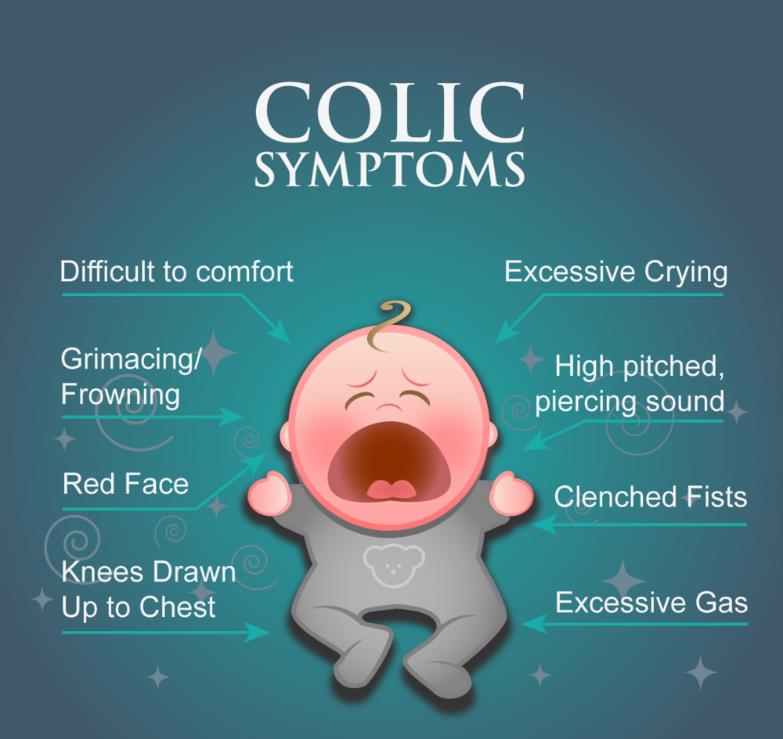Infantile colic is a frequent cause for visits to a paediatrician and to the emergency room and considered to be one of the most frequent reasons parents seek medical attention for their children during the first weeks of life.
Colic is frequent, prolonged and intense crying or fussiness in a healthy infant. Colic can be particularly frustrating for parents because the baby’s distress occurs for no apparent reason and no amount of consoling seems to bring any relief. These episodes often occur in the evening, when parents themselves are often tired.
Although in reality all newborns cry, colic is one of the main reasons that causes continuous disorders. Crying begins suddenly for no apparent reason and the parents cannot appease their child.
It is very frequent in children: 2 out of 5 newborns suffer from continuous colic, day and night, the “tummy” is home to gaseous colic, due to the incomplete development of its digestive system.
Episodes of colic usually peak when an infant is about 6 weeks old and decline significantly after 6 to 9 months of age. While the excessive crying will resolve with time, managing colic adds significant stress to caring for your newborn child.
Colic in newborns is an acute painful syndrome, of considerable intensity, which, due to spastic contraction of the muscular wall in the abdominal site, causes strong and sudden pain.
They are a disorder that causes great stress in the newborn and also in the parents, sometimes even anxiety and depression in the case of the first child, but it is good to be aware that they tend to resolve within a few weeks without any permanent consequences on the newborn.
You can take steps that may lessen the severity and duration of colic episodes, alleviate your own stress, and bolster confidence in your parent-child connection.
Colic is diagnosed using “Wessel Criteria- rule of 3”: crying for 3 hours or more per day, for at least 3 days per week, and persists for at least three weeks. Of course, some children even cry for many more hours, days and even weeks.

The main symptom of colic in newborns is the intense pain that develops in the abdominal area. Fussing and crying are normal for infants, especially during the first three months. And the range for what is normal crying is difficult to pin down.
Sometimes there is relief in symptoms after the infant passes gas or has a bowel movement. Gas is likely the result of swallowed air during prolonged crying.
Excessive, inconsolable crying may be colic or an indication of an illness or condition that causes pain or discomfort. Schedule an appointment with your child’s doctor for a thorough exam if your infant experiences excessive crying or other signs or symptoms of colic.

The cause of colic is unknown. It may result from numerous contributing factors. While a number of causes have been explored, it’s difficult for researchers to account for all the important features, such as why it usually begins late in the first month of life, how it varies among infants, why it happens at certain times of day and why it resolves on its own in time.
The cause of colic is unknown. It may result from numerous contributing factors. While a number of causes have been explored, it’s difficult for researchers to account for all the important features, such as why it usually begins late in the first month of life, how it varies among infants, why it happens at certain times of day and why it resolves on its own in time.
Risk factors for colic are not well-understood. Research has not shown differences in risk when the following factors were considered:
Colic does not cause short-term or long-term medical problems for a child. Colic is stressful for parents. Research has shown an association between colic and the following problems with parent well-being:
The stress of calming a crying baby has sometimes prompted parents to shake or otherwise harm their child. Shaking a baby can cause serious damage to the brain and death. The risk of these uncontrolled reactions is greater if parents don’t have information about soothing a crying child, education about colic and the support needed for caring for an infant with colic.
Dietary: hypoallergenic formulas (not proven to be effective for preventing or treating infant colic).
Physical: have proven to be ineffective and impractical.
Behavioral: have proven to be ineffective and impractical.
Pharmacological:
Among these plants, fennel is the most frequently recommended. The beneficial effect of fennel is attributed to its volatile oil (the highest concentration of which is found in seeds). Animal experiments have demonstrated that fennel seed extract reduces intestinal spasms and increases motility of the small intestine
References:
1. Balon AJ. Management of infantile colic. Amer Pham Physician 1997;55:235-242
2. Gurry D. Infantile colic. Australian Pham Phys 1994;23(3):337-346
3. Metcalf TJ, Irons TG, Sher LD, et al. Simethicone in the treatment of infant colic: a randomized, placebo-controlled, multicenter trial. Pediatrics 1994;94:29-34
4. Danielson B, Hwang CP. Treatment of infantile colic with surface active substance (simethicone). Acta Pediatr Scand 1985;74:446-50
5. Lipton EL. Swaddling and child care practice: historical, cultural and experimentalobservations. Pediatrics. 1965;35:521-67.
6. Jain K, Gunasekaran D, Venkatesh C, Soundararajan P (2015). “Gripe Water Administration in Infants 1-6 months of Age-A Cross-sectional Study”. J Clin Diagn Res. 9 (11): SC06–8.
7. Blumenthal, Ivan (April 2000). “The Gripe Water Story”. Journal of the Royal Society of Medicine. 93 (4): 172–74.
8. Blumenthal, I. “The gripe water story.” 2000. The journal of the royal society of medicine. 93: 172-174.
Suitable from birth onwards
Works in Minutes